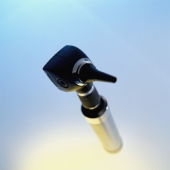
TUESDAY, Nov. 16 (HealthDay News) — Antibiotics may help more children with acute ear infections recover quickly, but the drugs also come with the risk of side effects, concludes a new analysis of previous research.
Between 4 and 10 percent of children experience side effects, such as diarrhea or rash, from antibiotic use, according to the analysis.
“If you have 100 healthy children with an acute ear infection, about 80 would get better with just over-the-counter pain and fever relief — but if you treated all 100 of those kids with antibiotics, you would quickly cure 92 of them. But, the number of children who would benefit is similar to the number of children who would experience side effects like diarrhea and rash,” explained the study’s lead author, Dr. Tumaini Coker, an assistant professor of pediatrics at the Mattel Children’s Hospital and the David Geffen School of Medicine at University of California Los Angeles.
“Parents really have to weigh the risks and benefits of treatment when a child has an ear infection,” she said.
In addition to finding that early prescribing of antibiotics offers some benefit in the treatment of ear infections, the researchers also found that newer, name-brand antibiotics didn’t appear to be any more effective than old stand-bys, such as amoxicillin, which are often generic and less expensive.
“Parents need to know that when a child gets an ear infection, antibiotic treatment might not always be the best option,” said Coker, who is also a researcher at the RAND Corporation, a non-profit research institute. “And, for most healthy children with a newly diagnosed ear infection, we couldn’t find any evidence that newer antibiotics worked any better than older ones.”
Acute ear infection (otitis media) is the most common reason that antibiotics are prescribed for children in the United States, according to background information in the study. The average cost of an ear infection is $350 per child, which ends up costing the entire health-care system about $2.8 billion annually.
The current review, conducted by the Southern California Evidence-Based Practice Center, looked at the diagnosis, management and outcomes of ear infections in 135 studies done from 1999 to 2010 on acute otitis media.
Coker said the purpose of the analysis was “to provide the best evidence for the American Academy of Pediatrics (AAP), since they are revising their guidelines for ear infections in children.”
The new analysis also found that when doctors use an otoscope to look in a child’s ear, the signs of a bulging tympanic membrane and redness are accurate ways to diagnose an acute ear infection.
In addition, the review confirmed what doctors had suspected would happen with the introduction of the pneumococcal conjugate vaccine (PCV7): the number of infections with bacteria covered in that vaccine went down. Unfortunately, ear infections caused by other bacteria increased.
None of the studies reviewed looked at the potential long-term harm of antibiotic use, such as antibiotic resistance, the researchers noted.
Results of the analysis are published in the Nov. 17 issue of the Journal of the American Medical Association.
Experts noted that this review, like many analyzing already published studies, have some inherent limitations.
“The problem with these kind of reviews is that most of the studies are old,” said Dr. Alejandro Hoberman, chief of the division of general academic pediatrics at Children’s Hospital of Pittsburgh. “We need better studies with clearer guidelines on diagnostic inclusion, and more stringent questions about antibiotic use,” he added, noting such research is currently underway.
Hoberman, who’s on the AAP committee for developing new guidelines, said there will be a new focus on improving the diagnosis of ear infections, so that those children who would benefit most from treatment will be the ones who are getting antibiotics.
More information
To learn more about ear infections in children, visit the U.S. National Institute on Deafness and Other Communication Disorders.

